Digging the Corpseflower
 The pear and the Russian prune hedge are just coming out; the forsythia's in full swing. Let's pray it doesn't freeze them all to black like last year. I don't trust God's rainbow promise. Spring in Ohio is usually brutal.
The pear and the Russian prune hedge are just coming out; the forsythia's in full swing. Let's pray it doesn't freeze them all to black like last year. I don't trust God's rainbow promise. Spring in Ohio is usually brutal.This is the time of year when the whitefly and aphids get so bad in the Garden Pod that trying to spray for them is like cleaning the house while the kids are around; like shoveling the driveway while it's still snowing. So I took advantage of a couple of warm thundery days last week to give everyone a two-day bath, washing the sticky aphid pee off the leaves, bumming out the whitefly colonies. I repotted plants that couldn't live another minute in their small pots, trimmed things back, groomed off the dead blossoms and leaves. And had to load everything back in when it dropped to the 40's Friday night. Sure enough, we had a mild freeze Monday night, which meant that I had to empty my linen closet to drape my 16' tall heirloom lilac with sheets. The whole garden looked like a yard sale, with sheets and pillowcases on everything. I'll stand out there with a space heater if it means I can save the blossoms this year. They all froze off last April 13. That is not going to happen this year if I have anything to say about it, because last spring nearly killed me.
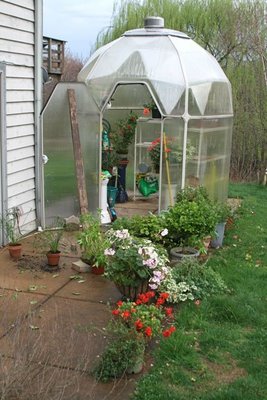 There is a terrible lot of biomass in that greenhouse by mid-April. Terrible. You can't even move in there without a clippers in your hand. But I've got to deal with it until at least May first.
There is a terrible lot of biomass in that greenhouse by mid-April. Terrible. You can't even move in there without a clippers in your hand. But I've got to deal with it until at least May first.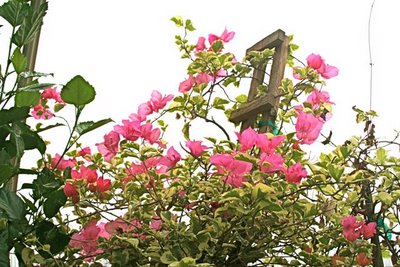 The bougainvilleas have done terrifically well this winter. I love these prickly old things, whether they're blooming or not. Good thing, because as soon as I set the pots outside, that's the last I'll see of flowers until next January. Go figure.
The bougainvilleas have done terrifically well this winter. I love these prickly old things, whether they're blooming or not. Good thing, because as soon as I set the pots outside, that's the last I'll see of flowers until next January. Go figure.Sauromatum venosum, or corpseflower, is a truly icky plant. That's why I love it. A member of the Araceae, or jack-in-the-pulpit family, it has a long blackish-red spathe and a greenish spadix that it sends up in early summer from a bulb that can attain truly titanic proportions. The flower smells like something died. See my post, "Look, Darling, The Corpseflower is in Bloom!" from March 2006, when nobody but Mr. Gold Wow Powerleveling Runescape had much to say to me. The miracle of it all is that it's hardy over our Ohio winters. I plant it right near the front door so I won't miss it when it blooms, because that dark blackish-red color kind of fades into the background. This is the flower of a 1" bulb. You can imagine what a 6" bulb puts forth...Peeeee---yewwwww. But don't worry. The flower only lasts a couple of days. Then it sends up a single fantastic 2-3' wide pinnate leaf on a long stem that's speckled like a gecko.
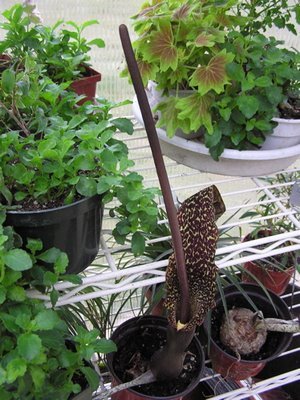 Sauromatum, with flowers that smell like rotting flesh, isn't for everybody, but the bulbs multiply and I've sent them to two similarly twisted friends already since I got my first, tiny bulbs from my friend Dave about three years ago. By the way, the rot smell is to attract fly and beetle pollinators. It works. I found the blossom among the hostas last year by following the smell and the sound of buzzing flies, expecting to find oh, maybe a dead raccoon.
Sauromatum, with flowers that smell like rotting flesh, isn't for everybody, but the bulbs multiply and I've sent them to two similarly twisted friends already since I got my first, tiny bulbs from my friend Dave about three years ago. By the way, the rot smell is to attract fly and beetle pollinators. It works. I found the blossom among the hostas last year by following the smell and the sound of buzzing flies, expecting to find oh, maybe a dead raccoon. 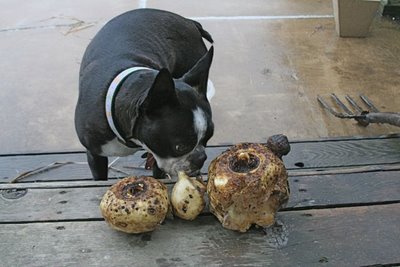 Mini-Baker fix, just so you know he's still alive and kicking. Sorry for the dearth of doggeh posts. I've been traveling and gardening (working like a mule). Bacon is still up to his old tricks.
Mini-Baker fix, just so you know he's still alive and kicking. Sorry for the dearth of doggeh posts. I've been traveling and gardening (working like a mule). Bacon is still up to his old tricks.I wanted to send a bulb to a special friend in New Jersey before they started growing for the spring, so I gingerly forked around where they were lying, dormant, under the soil. I was a bit concerned that all the tubers I dug up had soft gooshy spots, but I scraped out the rotten pulp until I got to firm living bulbflesh, washed the bulbs, and replanted them. I don't think there's much that's going to stop these things.
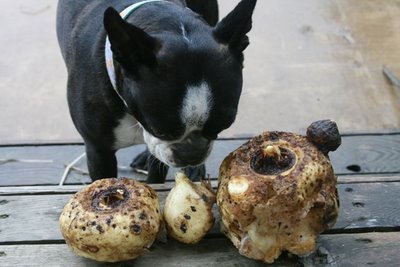
You can see where I scooped out the flank of the huge bulb. I still think it's going to grow fine; in fact it's already working on its flower. Weird enough for you, Chet Baker?
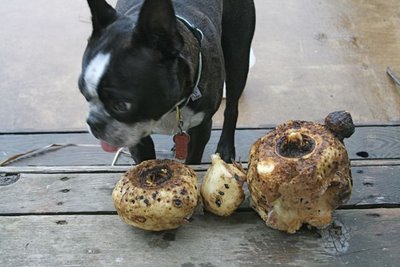
Mether. These are yucky. I am not a squeamish dog, but I have to wonder about a person who would plant something like this by her front door. There are other people in this house, you know. Namely me, Chet Baker. This bulb is bigger than my head. Do you remember last year, when I found the flower? Well, I thought it was something lovely to roll in, but it was only a plant.
Here's an excerpt from Scott D. Appell's wonderful writeup on the Brooklyn Botanic Garden's web site:
This tuberous aroid, hailing from the Himalaya, is considered to be subtropical (tolerating a minimum temperature of 41°F) and technically has no place here, but I am including it because I cultivated a four-foot-wide colony of it in Columbus, Ohio (Zone 6), through decades of freezing hibernal Midwest temperatures. It could prove hardy for you too! Considered a horticultural novelty, the voodoo lily tuber will produce its purple-mottled shiny green spathe and purple-brown spadix on a windowsill even without soil or water. The early-spring inflorescence grows up to 15 feet tall and emits a profoundly strong smell of carrion. (When I grew the plant, it attracted every fly in the neighborhood. "Did one of your cats die?" a neighbor inquired.) After its inflorescence fades, each tuber produces a single dark green, two-foot-tall leaf divided into numerous lance-shaped segments. The leaves have puce leopard spots on their petioles, and in large clumps they make an impressive tropical foliar display. By midsummer, the foliage shrivels away, but in fall, clusters of attractive red berries appear. The tubers multiply rapidly, making propagation from offsets easy. Plant the tubers six inches deep in fertile, well-drained soil and partial shade. With adequate protection in the colder areas, the voodoo lily can be hardy from Zones 6 to 9.
He grew 15' tall voodoo lilies in his Columbus garden?? Sounds like a soulmate. Stand by. Pictures of flowers in May or June. I just hope I'm here for the blooming, because it comes and goes in a couple of days.
Labels: bougainvillea, Chet Baker, corpseflower, Garden Pod, rainbow, Sauromatum venosum bulb, whitefly control





